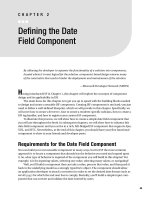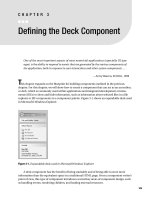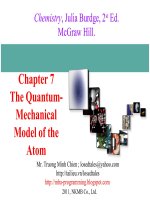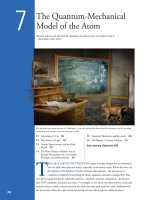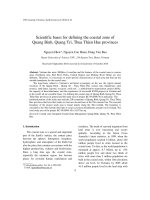Defining the atom
Bạn đang xem bản rút gọn của tài liệu. Xem và tải ngay bản đầy đủ của tài liệu tại đây (2.27 MB, 88 trang )
Defining the Atom
I.
Atomic Theory
A.
B.
C.
D.
E.
F.
All matter is made up of very tiny particles called atoms
Atoms of the SAME element are chemically alike
The atoms of an element have a definite mass that is
characteristic of the element
The Atoms of different elements have a different
number of protons in their nucleus (so atoms of
different elements have different atomic masses).
Atoms are not subdivided, created, or destroyed in
chemical reactions
Sizes of Atoms: Atomic Radius
1.
Atoms are about 1 X 10-12 m in size…so cannot be seen
(why we call it the atomic “theory”)
What makes elements different?
II.
What is an element?
1.
The atoms of different elements have a
different number of protons in their
nucleus
2.
An element is a substance that
cannot be broken down to any
simpler substance; made up of all
the same atoms each with the same
number of protons in the nucleus
3.
Examples: Hydrogen has just one
proton in it’s nucleus, Lithium has 3;
Berillium has 4; Sodium has 11.
4.
The number of protons in the nucleus
is called the atomic number!
Structure of the Atom
III. Structure of the Atom:
1.
2.
All atoms are composed of subatomic particles called
electrons, protons, and neutrons
Electrons, protons, and neutrons are different in terms of
their mass, electrical charge, and location in the atom
IV. Protons and neutrons have the same mass, while electrons
are much lighter.
V. Protons have a positive charge, neutrons are neutral (no
charge) and electrons have a negative charge
VI. Protons and neutrons are found in the center of an atom
(nucleus), while electrons are attracted to the protons on
the outside of the nucleus (opposite charges attract)
I. Minerals
•
•
•
•
All minerals are made up of single elements or compounds.
Element = a substance that cannot be broken down to any simpler
substance; made up of atoms
Atom = smallest part of an element; has all the properties the element has
but cannot be seen even with tools
Compound = substances consisting of more than one element
Minerals - definition
1.
Naturally Occurring
synthetic substances are not minerals
2.
Inorganic
plant and animal activities (coal, pearls are not minerals)
3. Solids
4. Definite Chemical Composition
5. Crystalline Structure
a crystal is a regular geometric solid shape; reflects the
ordered internal arrangement of atoms
6. Definite Set of Physical Properties
Physical Properties of Minerals
•
•
•
•
•
•
•
Can be used to identify minerals!
Color
Luster
Streak
Odor
Hardness
Breakage Pattern
– Cleavage
– Fracture
Color
•
•
Very useful property only for some minerals
Not useful for other minerals because:
– 1. Many minerals come in
multiple colors
– 2. One color (such as white)
can be seen in many minerals
– May be used for some of the
obvious minerals that are
almost always one color (sulfur
= yellow)
These are all samples of the same mineral!
Quartz comes in many colors!
These four minerals (and many
others) are all white!
Is color always a useful physical property
for identifying minerals?
•NO!
•
But it sure makes looking at minerals a lot
more interesting!
Luster
Luster...
•
•
•
•
•
The way light shines or glares off the surface of minerals
Better than color to identify minerals
Many types of luster have been described
Somewhat subjective
Need to familiarize yourself with terms...
Luster...
•
Metallic
– looks like metal in the way the
mineral reflects light (Galena
or Pyrite)
•
Non-Metallic
– Does not look like polished
metal, so other terms are used.
Types of Non-Metallic Luster
•
•
•
•
•
•
Vitreous - glassy, like glass (quartz)
Resinous - a dull shine, like a resin (amber, olivine)
Waxy - dull shine like candle wax (sulfur, olivine)
Adamantine - brilliant glow, beam of light at a certain angle (diamond)
Earthy - no shine at all (bauxite)
Pearly - looks like pearls when light is reflected off the minerals surface (opal, garnet)
The way light reflects off the surface of
a mineral (luster) is useful in
identifying the mineral
Galena definitely has a metallic luster
as it looks like polished metal
Graphite may display a
“sub-metallic” luster, as it
looks like dull metal
Quartz has a glassy look, which is
called a “vitreous” luster
Match the luster description with the appropriate
luster term by writing the correct number next to
the term:
Luster Term
Definitions
_______Pearly
1. a brilliant glow at certain angles under
the light; such as diamond
_______Dull (Earthy)
2. shines like reflected glass
_______Vitreous
3. no shine at all even under bright light
_______Waxy
4. glistens like pearls under light
_______Metallic
5. shines like candle wax, a dull glow
_______Adamantine
6. gives off a glare like a gold necklace or
silver bracelet
Streak
•
•
•
The color of the powder of a mineral obtained by rubbing the sample across an unglazed porcelain plate (called a
streak plate)
Most minerals display only one color of streak
Examples:
– Hematite always has a reddish brown streak, no matter what
color the sample is
– Sulfur has a yellow streak
– Sphalerite has a yellow streak
– Magnetite has a black streak
When checking the streak of a mineral,
be sure to follow these steps:
•
•
•
Hold streak plate
carefully with index
finger and thumb of one
hand
Hold streak plate firmly
against desk top
Rub mineral across plate
firmly to powder it
Checking streak...
•
•
•
Be careful not to break off the
corners of the streak plate.
Some streak plates have sharp
edges so WATCH OUT!
Check the color of the minerals
powder to determine streak.
Color, Luster, and Streak Quiz!
•
Color is the most useful property used to identify a mineral.
•
FALSE! Too many minerals are the same color and many are white, green, black, etc.
